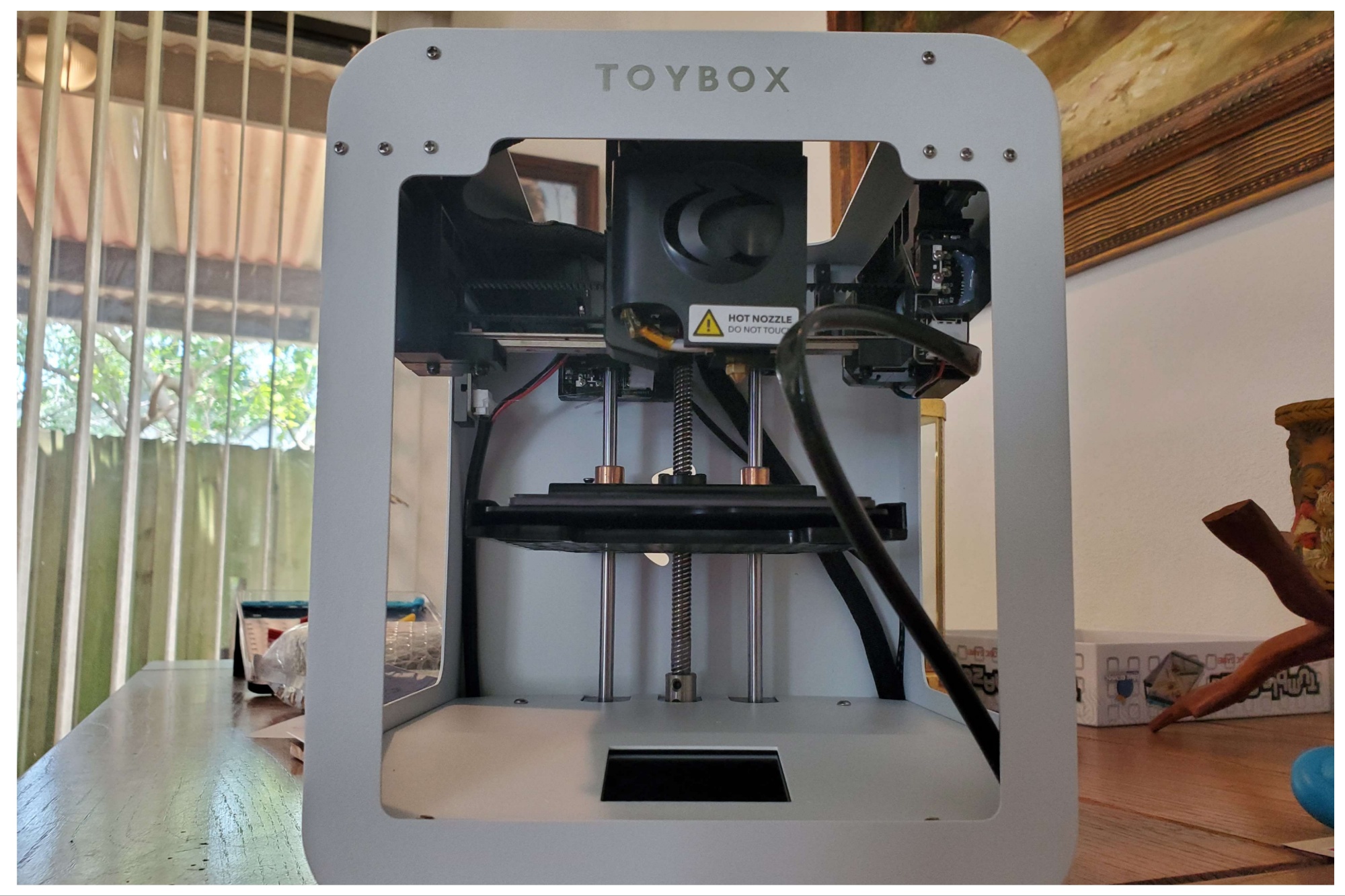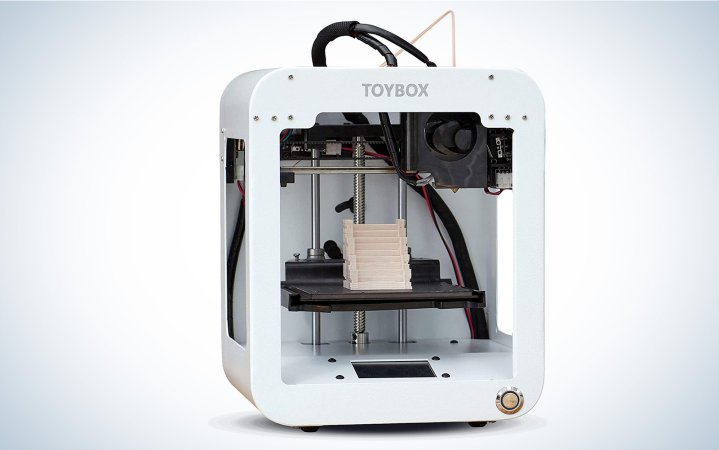

We may earn revenue from the products available on this page and participate in affiliate programs. Learn more ›
The Toybox 3D printer is an affordable, legitimately easy-to-use device that works quickly and intuitively even for total novices. Aimed as much at parents wanting to give their kids a leg up on new tech as it is at toy lovers of all ages, the Toybox 3D printer offers a short path from unboxing to printmaking. Furthermore, Toybox’s printing app and web tool give you legal access to proprietary figures—such as Universal Pictures’ Minions—making it an excellent 3D printer for cosplay accessories.
Pros
- Using this printer is very intuitive, and common sense will guide you through nearly every interaction
- Most toys just work as printed
- App provides plenty to print and do, giving you options to make predesigned toys as well as easily design your own
- Starter bundle’s included “printer food” (aka filament) adequate to make dozens of toys—no need to buy more right away
- When you do buy more printer food, it is very reasonably priced
- Easy to remove freshly printed toys from the printer
- Access—with paid subscription—to third-party intellectual property
- The sense of joy, wonder, and discovery as you go through the printer and app cannot be understated—cute little messages on the bottom of boxes, playful sounds during printing, usage of your own images to make certain toys, etc.
Cons
- Could use slightly more documentation, especially during initial setup
- Not all “create” tab toys worked perfectly
Overview
- A whimsical presentation gives a sense of discovery right away and continues to deliver throughout the process of using the printer.
- The printer explains itself and trusts you to make good decisions.
- You can hop in and start printing immediately, taking perhaps 30 minutes from box opening to having an entirely usable small toy in your hands.
Verdict: The Toybox 3D printer is a fantastic entrance into the new world of consumer-accessible 3D printing and a creative tool the whole family can enjoy, utilize, and learn from.
The setup
One of the first concerns when getting a 3D printer, especially one to be used with young people, is the setup. However, the Toybox 3D printer comes together quickly and easily. This is a 3D printer made for beginners, not experts. In general, this works out, though I admittedly wish my hand had been held a little harder as I began working with the $299 carefully calibrated cube.
Everything comes securely packed to protect sensitive electronics, but it’s easy to remove from the box. I wasn’t concerned in the slightest about seeing a damaged product or removing things delicately from the packaging. Instead, I was greeted by cute messages—the bottom of one box memorably taunts you for staring at its bottom—and “plant food,” what Toybox calls its PLA (Polylactic Acid) build medium filament.
Like an increasing number of modern electronics, the Toybox 3D printer is paper manual-free, through and through. Instead, a welcome placard sends you to the Toybox website. Here, a few-step guide will take you through removing the safety packaging from the inside of the printer, installing the “printer food” into the print head, and connecting the machine to your WiFi network via a smartphone.

This initial setup guidance is in the form of short bits of text accompanied by small, looping gifs. In general, this is enough. However, when it comes to yanking things out of pricey plastic, more guidance would have alleviated some anxiety. Take the two segments my fingers are pointing to above. Despite blending in quite well with the frame of the Toybox 3D printer (and doing so even better before I had moved them around a bit), these two pieces are to be removed. Despite small things like this, where a little bit of extra messaging would have been useful, the setup was incredibly easy.
Overall, a confident and careful teenager should be able to set up the Toybox 3D printer alone or with limited parental guidance. Within about 20 minutes, I fed my spool of thermoplastic “coconut printer food” in (there are nearly two-dozen flavors, aka colors, available) and was done with an initial calibration print. The leading edge of this initial print was a bit funky. I also didn’t feel 100% confident in exactly how it was supposed to look, but I knew it wasn’t supposed to look like what you see below. So, I made the executive decision to rerun the print.

Somewhat satisfied with the second print, I called it a day on that. It then dawned on me that this product was designed to just work. A new philosophy of just lean in and try things took over, and I headed to the Toybox app to see what I could print.
Note: In addition to the initial setup and calibration, a safety guide is included with the app, which I never felt the need to consult. If you encounter serious difficulties, there is a help forum linked from the app where you can discuss issues and make suggestions for future Toybox improvements/products.
The app
Once finished with the initial setup, you’ll want to poke around the app for a bit to find things to print. The main navigational tools you’ll want to use to find things to print are Explore, Create, and Play Packs.

The Explore tab gives you access to premade prints that have been tested and approved by the Toybox team. These are your best bet for quality prints that work every time and are the best place to start with your Toybox 3D printer. Options include completely free prints, prints that require “Bolts” (the app’s currency), and prints for Toybox Plus members. Prints that have third-party intellectual property are typically locked behind Bolts or a subscription.
Note: For the purposes of this review, Toybox provided a Toybox Plus membership.
Play Packs are a unique way to use the Toybox 3D printer and include parts that cannot be 3D printed but that can be customized with printed parts. If you’re not feeling particularly creative or want to do something a bit extra with your Toybox 3D printer, these guided activity kits are the way to go. They must be purchased separately, however, and are not included in this review. I highly recommend playing around with your printer, as is, for a while and doing your best to come up with your own ideas before springing for a Play Pack.
One of the most exciting parts of the Toybox app is the Create tab. It’s fun, but it can also lead to some frustration. While all of the other toys printed during the course of this review worked perfectly, I was unable to get the puzzle maker’s slide puzzle to work, even after several changes to the configuration and going back to default settings. To put it into perspective, though, this was my only negative interaction with the Toybox 3D printer.

Many Create tab creations, such as the printer pal shown above (a Toybox Plus exclusive), utilize sliders and are quite dynamic. The printer pal above—who I’ve named “John Guy”—was created through a series of menus that felt reminiscent of The Sims or Dark Souls character creator. Creating a printer pal that looked, and even appeared to feel, like me was intuitive and easy.
Other Create tab creations involve putting in an image—which the program will convert to grayscale and then use to AI-generate a 3D contour, which works well—but you can also choose your own pictures or even draw something directly in the app. Other image prints work by altering the insides of the print to create a “magic photo” that appears in the light. Some create tab toys are free, and others are exclusive to Toybox Plus members, though both are easy to find, locate, and use. The Create tab is also where you can, without a subscription, input your own (or third party) stl, obj, 3mf, or gcode files to make custom prints.
The print performance
When you’ve selected what you want to print, make sure the magnetic tray is fully inserted and press print. After a brief period of heating the nozzle, your print will begin, with a countdown to completion timer appearing on the app. You can check the progress by visiting the website on your phone, tablet, or computer. It’s always useful to watch the initial bit of the print to make sure it starts well, but once the print is successfully started, you are free to go.
Eager to get something out of the printer quickly, I found a selection of “quick print” options and went with something usable: a whistle. Quite appropriately, the Toybox 3D printer begins the printing process with a delightful robotic noise before beginning, and within a few minutes, I responded by blowing a very loud, usable, and annoying whistle (seen here).

Within about 45 minutes of touching the Toybox 3D printer, I was using a real toy. It can’t get much quicker or simpler than that. Next, I went for a larger toy, a big dinosaur glasses holder, which allowed for a better peek at the insides of a typical Toybox 3D Printer print.

The insides create a sort of “lattice” that makes the prints even more cost-efficient. Each spool of printer food, which typically costs $11 or $15, can make dozens of reasonably sized toys (the printer does not have a giant build area) from the Toybox Labs app. The hollow insides keep the final product light, as well, but do reduce their structural integrity. When finished, the dinosaur glasses holder was hard as a rock despite its largely empty interior.

When finished, the prints are ready to be taken out immediately and should already be in a hardened form. The prints are surrounded by a perimeter line that needs to be cleaned away and may have some webbing, even on the best of prints. This can be easily cleaned away. Except for the aforementioned slidey puzzle, all prints with moving parts worked upon removal from the printer.

Finalized pieces look generally rather impressive, with the pieces’ key features showing up clearly. The plant food PLA gives off a very clean shine. Expect exposed upper surfaces to appear somewhat voxelized or reminiscent of a geographical height map when inspected up close. It isn’t uncommon to find imperfections that resemble small animal scratches on the undersides of pieces with larger bottoms, though toys that display—or are affected by—these imperfections are few and far between.
The conclusion
For a machine that fits snugly into the best 3D printers under $500 category, I could not imagine a more delightful start into the world of additive manufacturing. You can generally just expect things to work and not get overburdened with settings, tinkering, or the minutiae that might have scared you away from 3D printing in the first place.
Associated costs with the printer, such as subscription fees for full access, make the Toybox 3D printer less of a casual entry point but still a very likely launching point for a 3D printing enthusiast creating toys and other small objects. This is a 3D printer for kids and teens—though I, as an adult, enjoyed it immensely and will likely continue to use it—so the ability to grow out of it is only to be expected. Toybox’s environment encourages exploration, self-confidence, and discovery and will help you on your 3D printer journey, whether that leads to sci-fi-like food replicators, fabricating concept cars, or just adding to a collection of adorable caricatures.

